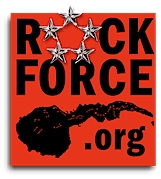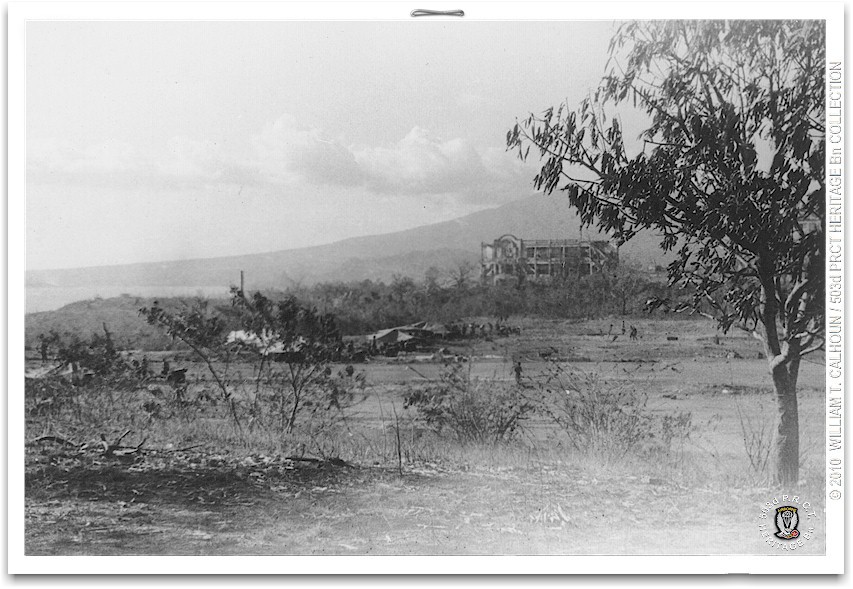|
|
|
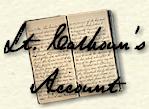
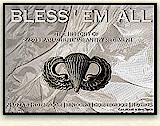

|
The
entire company moved down to the rim between Batteries Smith and Grubbs
early this morning. We knew there were Japs in Grubbs Ravine, and today
we were to clean them out.
Remember, what we now know today as Grubbs Ravine was called Sheeney
Ravine in the F Company history. We knew that Grubbs Trail running along
the north slope of Sunset Ridge intersected the asphalt-surfaced North
Shore Road near the sea. We had traveled this route the day before in
returning from the Cape Corregidor area to Battery Smith. We had seen
that North Shore Road turned sharply from the sea eastward up the depths
of the ravine. On the map we could see that after about two hundred
yards it reversed itself and ran back, westward, toward the sea. In
other words North Shore road made a "V" here with the apex in the very
bottom of the ravine. On the north slope of Grubbs Ravine, Way Hill
ridge, was another trail running along the slope, Rock Point Trail.
Since the ridges dominated the ravine it was obvious that they must be
occupied by friendly force before a force could sweep the ravine. The
2nd platoon was ordered to move down Grubbs Trail and occupy it all the
way to the junction of Grubbs Trail with North Shore Road. The 3rd
platoon was ordered to move down Rock Point Trail and occupy it to the
point where it turn( sharply back to the northeast. In these positions
the platoons would be on each side of the ravine looking down on the "V"
and the stretches of North Shore Road running back to the sea. As I've
said previously, even though the area was covered by large trees, the
bombings and shellings had cleared out so much foliage so that
visibility was good. As E Co. passed up the road the 21st, they surely
saw the "V" below passing over a road culvert. Visible also nearby
sitting on the bank of the dry stream bed was a small, metal covered
building (corrugated steel roofing) about 12 feet x 12 feet in area.
The
first platoon was given the mission on sweeping the ravine as a line of
skirmishers. The 4th platoon would follow about fifty yards to our rear.
Immediately behind them was the attached light machine gun platoon, 2nd
Lt MacKenzie's 3rd platoon.
In
addition to our platoon medic, Pfc. Jensrud, the company medic was also
attached. This was T-5 William E. Ashton. At least one flame-thrower
team and a demolition team were also attached. We waited on the rim
prepared to move out down the steep incline.
After
a time both the 2nd and the 3rd platoons radioed in that they were in
position. Lt. Bailey and I both were surprised that they had reached
their objectives so quickly and with no opposition. He questioned both
platoon sergeants and was assured that they were in position. So we
crossed our line of departure.
The
upper part of the ravine was completely cleared of trees and vegetation.
After about a hundred yards we entered the tree cover. As I've said, the
trees were large, but the foliage was cleared out enough for visibility
to be good. I was exactly in the middle of the ravine walking down a dry
stream bed, and I could see my entire skirmish line going up both
slopes. They could see me and thus the line stayed relatively even. We
moved slowly. The ground was rough and sloped steeply. In addition the
bombs and shells had cut thousands of branches off so that there was a
cover of debris to negotiate. I was walking in the rocky stream bed with
banks about two to three feet high as we neared the "V". We knew the
enemy was there waiting to get us in the most advantageous position for
him to open fire. We just hoped that our troops on the flanks would spot
the enemy as soon as he showed himself. It was hot, but I think we were
perspiring more than usual because of the tension. There is much
unnerving about walking straight forward making a target of yourself to
induce the enemy to open fire.
We
came to the area where we could see the metal-covered building on the
left bank. As I drew even with the building I could see the road culvert
about twenty feet past the building. Pfc. Stanley Maciborski was walking
along the bank on my immediate left. He passed the building without
looking in the door which was on the west side. I hopped out of the
stream bed to take a look. Pvt. George Mikel, my extra runner, was
walking on the right, north, bank on my immediate right. He saw what I
was doing and hopped down into the streambed to follow me.
At
this moment a shotgun blast broke the silence and, on that signal, all
hell broke loose.
Rifle
and machine gun fire seemed to be coming from everywhere. The enemy had
waited until we got to his planned spot and opened up front and both
flanks. Our men had to take what cover they could and lie very quietly.
I notified Lt. Bailey of the situation. He said to hold on until the two
flanking platoons got into their positions. The following radio
transmissions turned the air blue. Machine gun fire was coming from
above us on Rock Point Trail along with rifle fire. Rifle fire was
coming from the culvert (RC-6). The heaviest machine gun and rifle fire
was coming from the area between Grubbs Trail and North Shore Road
toward the junction. There were two cave entrances there. This was an
open area and the Japs were out of the caves (actually it was one huge
cave) and pouring it on us. The Jap defenses actually had been set up to
repel an attack from the sea. For example, the culvert's side toward us
(east)
was open. The west
side
was covered with stones and concrete slabs built up as a wall with slits
left to fire through. Then there was a machine gun, one at least, up on
our left flank around the trail firing down our line. I knew Maciborski
had been hit and was lying there. Lying beside the building I looked
down into the streambed and saw George Mikel lying on his back on the
large stones. I could not tell if he was alive. On the other side of the
streambed crouching behind a tree trunk about ten inches thick was Sgt
Todd. I told him to get flat, that the tree wasn't big enough to cover
him. I could see the 4th platoon coming straight down the streambed. I
told Todd to hold everyone in place, that I was going to try and get to
the mortar platoon and get them into action. Not knowing if Mikel was
alive I told him not to move. I was going to get the mortars in place,
and we'd have him out in a little while. I ran to the mortar platoon,
scared the same way Russian Porzucek said he was the third night. The
mortar platoon set-up and zeroed in on the open area between the road
and the trail. This fire drove the Japs back into the two entrances.
About this time the 2nd platoon arrived and knocked out the Jap machine
gun up near the trail. The 3rd platoon, also, had arrived and cleared
the right flank. The 2nd platoon moved on down to the junction and held
the entire trail. They were above the cave entrances.
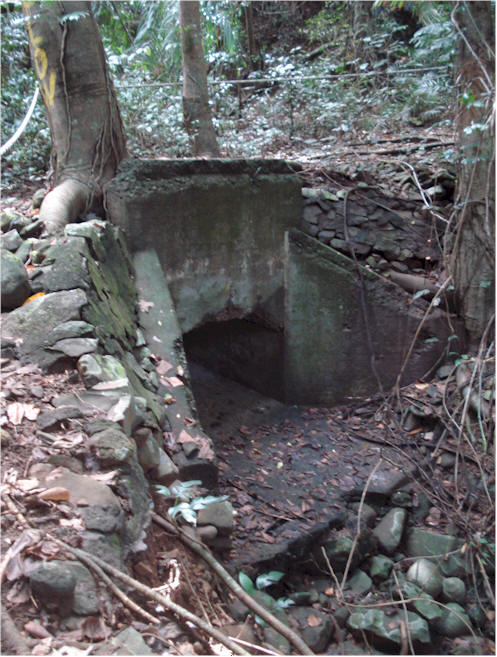
I got
back to the platoon just as Pfc. James Wilson threw a WP grenade into
the culvert. When it exploded he jumped down into the stream bed and
sprayed the area inside the culvert with his Thompson Sub Machine Gun.
He killed eight Japs under there. Immediately afterwards, Pfc. Theodore Yocum ran across the road near the culvert and just as he reached the
other side was hit in the head. He quivered and then was limp. Death was
almost instantaneous. Mikel was dead. After I left he sat up, despite
Todd's protest. At least one rifle bullet fired from a rifleman in the
culvert had ripped through his chest. His first wound had been a bullet
in the upper part of his thigh. The Japs evidently thought he was dead
and had not fired again until he sat up. Pfc Paul Narrow was on the
right slope. When the Japs opened up he was hit and died quickly.
William Ashton saw him fall and ran through a hail of bullets to render
medical aid. Ashton was shot but survived.
Lt.
MacKenzie, going to Ashton's aid, was killed.
On
the left front the Japs were still in the cave and firing out through
the openings. Suddenly a great shower of potato masher hand grenades
came flying out of the openings toward us. They landed well short and
did no damage -- just caused a lot of noise. The 2nd platoon, or the
demo team which had moved up with them, was trying to swing satchel
charges into the cave openings from above, and the flame thrower, or
throwers, were working along the slope to get within range of the
entrances. I went up the right slope to check on our 1st squad.
|
|

James Bradley |
Pfc
James Bradley, 2nd squad, was on the left slope. He says: "I do not
remember if there was anymore than our platoon when we started out or
not, but we were about half way down the canyon when the Japs started
picking off some of our group on the right flank. It must have been
Grubbs Ravine when we had the 2nd platoon with us. Our squad was on the
direct end of the left flank and we were able to move without drawing
fire. I remember that Mike Natalie and I found the mouth of the cave the
Japs were in. We dropped several grenades into the opening and were able
to drop to the roadway and dropped more grenades into a culvert where
the Japs had holed up. It was here that Theodore Yocum caught one that
was intended for me. I do not know to this day who yelled "look out
Bradley!"' it may have been Yocum who called out. Anyway I ducked just
in time, but I am sure that it was the same time that Yocum died. We
tried satchel charges of TNT etc. And still the Japs would not come out.
Then we emptied all the fuel we had in about four or five flame
throwers, then we ignited it with the last flame thrower. It must have
been pretty awful in there because they finally came running out of the
cave. Half the poor buggers were on fire as they came running out. I
remember Lampman standing behind a tree picking them off with his B.A.R.
I remember I was out of ammo and unable to be of any assistance. At that
time I guess it was really the only time I felt any anger for the Japs." |
|

Richard Lampman |
"We
ran into a large cave complex before we realized it was there. We called
for a demolition team and when they arrived they had used such a large
charge we almost lost one of the demo team. The bank gave way; only
quick action by the other members of the team saved him from going down
the mountain." |
|
|
|
 |
I
missed the flame thrower action, because I was up the north slope at
this time. The Japs had been pinned on the south slope. The two squads
on the north slope were still receiving heavy machine gun and rifle
fire. I did not, nor did anyone else see all the action. As the ancient
Greek said a man only sees in combat only that which happens nearby and
that only imperfectly. |
|
|
|
|

Bill Bailey |
"It
was down this ravine where the Japs were holed up in a culvert under a
Bottomside Road and proved so difficult to wrinkle out. Sgt. Mikel was
killed here and I believe 3 more K.I.A.'s before our flame throwers
convinced the Nips to come out, one after the other running full bore
only to be met by converging fire from everyone. I have no memory of a
fourth man being killed here and have only recently become convinced
that another was killed." |
|
|
|
 |
The
machine gunners from 2d Battalion Headquarters Company were following my
platoon. I do not remember if it was one section or the entire platoon.
They must have been to the right of the mortar men. This would put them
on the north slope behind our 1st and 3d squads. The platoon leader of
the 3d light machine gun platoon was 2d Lieutenant Clifford MacKenzie. |
|
|
|
 |
"The
report from "F" Co. came in a little while ago; they ran into stiff
machine gun opposition and has three killed and two wounded. One of
those killed was Lt. MacKenzie of this company. One other was hit with
buckshot all over his face and chest." |
|
|
|
 |
Of
course I knew three men from "F" company were killed- and, since I did not
remember that MacKenzie was killed, I felt that this entry was mistaken.
I also felt Bill Bailey must be mistaken in his belief that four were
killed.
Then during the
month of May, 1991 I came into possession of part of XI Corps General
Order Number 11, 10 March 1945. Under "SECTION I................. SILVER
STAR MEDAL - Posthumous awards" was the following citation:
|
SECOND LIEUTENANT CLIFFORD MACKENZIE |
|
01305117,
Infantry, United States Army. For
gallantry in action at Corregidor, Philippine Islands on 22
February 1945. During an attack by our troops, a platoon was
pinned down under a hail of light machine gun fire. One of
the men in the platoon sustained mortal wounds and another
soldier going to his aid was seriously wounded. Fully aware
of the risks involved and totally disregarding the possible
consequences, Lieutenant MacKenzie unhesitatingly plunged
through the withering fire toward the wounded man and in so
doing lost his life. Lieutenant MacKenzie's display of
valor, beyond the call of duty exemplifies the highest
traditions of the military service. Next of kin: Mr. William
S. MacKenzie, (father), 1410 Cortelyon Road, Brooklyn, New
York." |
|
|
|
|
|
|
I am
now convinced that I am the one who has been mistaken and that Clifford
MacKenzie did, indeed, die that morning in Grubbs Ravine. I had read
Bennett Guthrie's account of MacKenzie's death in his book: "Three Winds
of Death." This had not meant much to me because, in paraphrasing the
citation, Guthrie had stated that the action took place during a
Headquarters Company patrol. There are instances where a mistake was
made in the date of an action, but I believe now that the evidence rules
this out. First of all, MacKenzie's platoon was the machine gun
platoon ordinarily attached to F Company. Second, in following the
squads on the north slope (this slope was about twice as long as was the
south slope) MacKenzie would have been in perfect position to see what
happened in front of him. Third, The 1st and 3d squads, on the north
slope, came under the heaviest machine gun fire from the vicinity of
Rock Point Trail. Fourth, Pfc Paul Narrow, 1st squad, was hit and
killed. T-5 William E. Ashton, the company medic rushed to his aid and
was hit by machine gun bullets in both ankles. The logical assumption
was that MacKenzie was killed going to the aid of Ashton. Fifth, there
was no other action which I know of which could fit this citation.
In
my memory I thought I talked to MacKenzie as we left the area going back
up Grubbs Ravine. This is not true, and my memory of MacKenzie is not
right. Since I had worked with MacKenzie and his platoon since we had
jumped on Corregidor I came to know and trust him. I really think he was
on Battery Hearn Magazine the third night with his machine gun section,
but there was too much confusion that night for me to be sure.
Doc
Bradford also accompanied "F" Company down into the ravine. Doc really got
around. A few years ago he wrote me a pretty good account of this fight
from his memory after all these years. He said in effect that as he
remembered ' .. I was conducting the operation down in the draw." |
|
|
The
cave openings were dirt openings. No concrete had been used at all. As
I've said previously, we thought they were
two
caves
while they really were openings into two tunnels which led back into a
huge cave. There was a third opening. About fifty yards to the east just
above Grubbs Trail was an almost vertical shaft opening into the cave
which apparently was a ventilator shaft. Evidently the Japs had not
backed far back into the cave when the flame throwers kept spraying
their fluid into the entrances. They must have been staying close enough
to the openings to get a shot at any of us who exposed ourselves. Then
when the flame thrower operator flicked the igniter the fluid covering
everything instantly became a raging inferno catching the Japs by
surprise, and they became human torches.
The
demolition section carried satchel charges and there were too few
explosives for the large job of closing these entrances. Regimental
Headquarters suffered five men KIA on Corregidor, and I believe all were
in demolition sections. The effects of their work may have been less
than desired, but the efforts of these men certainly were beyond
question. The effects of their works was limited only because of their
human load limits.
Lt
Bailey told me to take my platoon on back to our bivouac area at the
lighthouse and let them rest. As a consequence I did not see the final
efforts at sealing the entrances.
We
moved back to the lighthouse with sadden hearts. Three more of our own
gone. Theodore Yocum's two young sons were now fatherless. Paul Narrow
could have been a civilian back home enjoying life in the roll of a hero
who had already done his duty. He had jumped in North Africa as a member
of the 509th Parachute Battalion. His arm had been badly shot-up, and he
had been returned to the States. He had to go to great lengths to
convince Army doctors not to discharge him. He was happy and, he said,
lucky to be in the 503d.
As
noted in the the company history and Bill Bailey's statement, George
Mikel was still called Sergeant Mikel. As a member of the 501st
Parachute Battalion he could have been rotated home, but he flatly
refused saying the 503d was his "my only home," and predicting that he
would die in the company. He confided this to me on several occasions.
When a company
suffered casualties usually a detail was assembled on Topside and sent
down to carry out the dead and wounded. I have learned in the past few
years that S/Sgt Bryan Ownby, 81mm mortar platoon, 2d Battalion
Headquarters Company, was in charge of the detail sent down by battalion
to collect our casualties. These litter parties were standard operating
procedure (SOP).
Bryan
Ownby and George Mikel were old non-commissioned officers in the battalion and
were well acquainted, so Bryan's memory of his detail picking up Mikel's
body that morning is still vivid. No-one forgets the shock of suddenly
seeing an old friend, a brother, lying there dead.
These
carrying parties turned the bodies of the dead over to Graves
Registration for removal to the designated site and burial. It is a sad
commentary to make about American soldiers, but some of the Graves
Registration men looted bodies. Regulations required the deceased's
effects to be placed in a rubber bag, sealed, and returned to the
deceased's company in order for the appointed summary courts officer to
send these personal effects to the next of kin. Many times, as in
Mikel's case, no personal effects ever came.
George
Mikel had a wife in Australia, but he had failed to get official
permission as required by regulations, so the marriage was not valid to
our officials. George knew this and had no illusions about his wife
collecting his insurance. Consequently, he collected all the Jap
artifacts he could and sold them to air force, navy, and service
personnel. This money was sent back to his wife in Australia. Both
Phillip Todd and I knew that George had 800 pesos ($400.00) in his
wallet which he kept in the buttoned-down left breast pocket of his
fatigues, an expensive camera, and a good watch with himself that
morning. No personal effects for George Mikel ever came through. I am
dead sure of this, because I was summary courts officer for the company
back on Mindoro. A good soldier died that morning as he had predicted
that he would. I am glad to know that he was in good hands for a short
time until they reached Topside, and I appreciate Bryan telling me this.
Sgt. Ownby and his detail followed our force as we swept down Grubbs Ravine
that morning. After the action started, Bryan risked his life in going
forward to rescue some of our casualties. For his bravery he was awarded
the Bronze Star Medal for Heroic Achievement.
|
|
|
 |
|
|
 |
|

